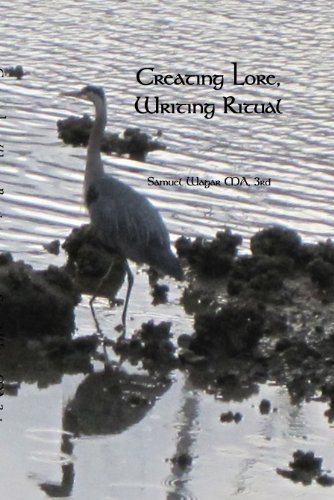Creating Lore, Writing Ritual is not a typical entry into the library of pagan writings. For a start, it is thoroughly researched and referenced, employing nearly 70 footnotes and offering 8 pages of suggested further readings and bibliographical citations. This doesn't make a book either good or bad, but it certainly begins to frame the mindset of the author and his expectations for the mindset of the reader. This is not a book to charge your soul with light or to uncover hitherto-unknown connections between yourself and [pick a deity or aspect]. Since he doesn't promise these things that's fine. What author Samuel Wagar has provided for us is a scholarly delve into the purposes and processes of ritual, along with suggested methods for creating and performing them.
While the "Writing Ritual" portion of the book is much larger, the twenty or so pages he devotes to "Creating Lore" packs a lot of punch to it. I think it's important to note that Mr. Wagar has some very definite ideas on subjects like the freedom to believe whatever you want, and while he is clearly taking pains to validate the right of other's to hold such opinions he believes that there is a better way and worse way to construct one's lore. In my experience, his tone is at odds with most authors in the new age / pagan world; I found his work valuable, but if you think you'd be put off by sentences like "[h]owever, as a general case and away from the specifics of our teacher or our fraction of the community's body of lore, I believe that we all have a general sense of what is undoubtedly Wiccan, what may be Wiccan, what's probably not Wiccan and what's not Wiccan (although it may be perfectly valid for those who like that sort of thing)" then you might save yourself the pain. On the OTHER hand, "[t]he Three-fold Law originally read more-or-less "as you harmed, return three times but remember that you are obliged to repay good three times" and was part of an Initiation ritual for 2nd degree, not a general purpose moral injunction" blew my mind. The recommendation of this reviewer is that whatever difficulty you may have at times is worth the pain for what you can learn.
In the portion of the book dedicated to ritual writing, he starts with observations on the meta: where the ritual will be performed, with and for whom, He addresses five levels of size for doing rituals, including: solitary, partner/family, coven/moon group, temple/grove, and community/festival circle.It does seem, however, that he is having to theorize more on solitary work while being able to speak from experience on the other groupings. For just one example he does take care to discuss the need to accommodate participants with special needs, including the elderly, as well as those who have brought children; solutions that I suspect are only arrived at through experience. The advice to the solo practitioner did not seem nearly so useful, although perhaps from his perspective it's just so much simpler that less advice is needed. From there, we are led through a variety of ritual purposes and the challenges each presents: sabbats, rituals of communion and of passage, festivals, times of transformation and so on. Mr. Wagar does a very good job in explaining the differences in how to go about preparing and performing each.
Nearly half of the book is given over to sample rituals from a wide variety of sources - although most all rituals from other authors are adapted in some fashion by the author, and he makes clear note of this in each case. Nevertheless, they present a wide variety of style and methodology; I hazard to say that unless you are particularly well-read in the rituals of many traditions then more than one of these will cause you to think "I never would have considered that for a ritual!" This resource alone is probably worth the price of admission so to speak. I doubt that many of the rituals provided will be of use to anyone without some amount of modification, nevertheless they serve as either a jumping-off point to be modified to suit your needs or else pure inspiration from which you can craft your own from scratch.
~ review by Patricia Mullen
Author: Samuel Wagar
Obscure Pagan Press, 2012
pp. 200
Creating Lore, Writing Ritual

©
2010 - 2024
Facing North
